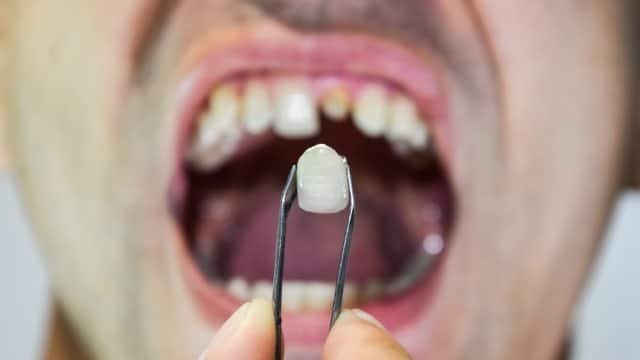Breaking a tooth is traumatic, but quick action and a visit to the dentist fixes cosmetic damage and helps prevent long-term problems. Teeth break as a result of forceful impacts, such as those that occur in car accidents or sports, or due to dental problems such as large cavities or lost fillings. Whatever the cause may be, a dental visit is needed either immediately or as soon as is convenient, depending on how badly the tooth is broken.
What Happens When a Tooth Breaks
A broken tooth can range from a chip in the hard enamel exterior to the complete breakage of an area, leaving the dentin and pulp exposed. Tooth enamel contains no nerves or blood vessels, according to the Harvard Medical School, so enamel loss may cause no pain. When the dentin or pulp is exposed to the air, however, the tooth often hurts. Bacteria can infect exposed pulp over time, causing more pain, discoloration of the remaining enamel and sensitivity to temperature changes. There may also be pain from the injury that broke the tooth, whether or not the dentin or pulp is exposed.
What You Should Do
Home emergency treatment increases the chances of a good outcome. The University of Iowa College of Dentistry and Dental Clinics explains the steps to follow if you break a tooth:
Gather the broken pieces and place them in a clean, dry container for transport to the dentist.
Rinse the remaining tooth with warm water to remove dirt and debris.
If an injury broke the tooth, place a cold compress on the area to help prevent swelling.
Call your dentist to arrange an appointment. If you can see yellow dentin or red, exposed pulp, see a dentist immediately.
The Harvard Medical School also suggests avoiding hard foods and covering the sharp edges of the remaining tooth with dental wax or chewing gum to protect the gums.
Sometimes a broken tooth is not the only effect of an injury to the mouth. The University of Maryland Medical Center warns that a severe impact can break the jaw. If you cannot bring your upper and lower teeth together when closing the mouth, see a dentist or go to the emergency room immediately.
What Happens After
The correct treatment for a broken tooth depends on the extent of the damage. Dental pulp that is infected with bacteria dies over time. It must be removed and replaced with a plastic filling in a root canal procedure. Dentists sometimes wait to see if the pulp is infected, in which case a temporary crown may be placed over the broken tooth. If the pulp is not infected but the tooth is missing a large chip, a crown will restore the tooth's cosmetic appearance. Usually the tooth can be repaired when only a small chip is lost. If you’re trying to care for a crown or repaired tooth, regular flossing and brushing with a toothpaste the fluoride formula of which strengthens teeth to help prevent cavities is recommended.
Precautionary measures such as sport mouthguards help prevent broken teeth, but sometimes accidents still happen. When a tooth breaks, following a few simple steps can help dentists provide the best possible treatment. Eventually, they will restore your smile.
Learn more about fractured and broken teeth in the Colgate Oral Care resources.





